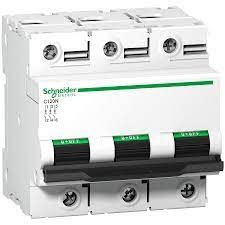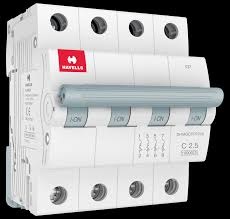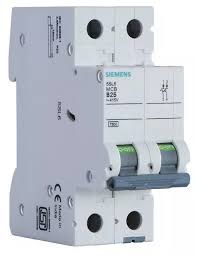MCB | MCB Full Form | MCB Full Form in Electrical | MCB Full Form in Hindi | एमसीबी फुल फॉर्म हिंदी में | Mini Circuit Breaker
MCB Full Form in Electrical is Miniature Circuit Breakers (MCBs) are essential components in modern electrical systems, providing reliable protection against electrical faults and overloads. If you're unfamiliar with MCBs, you may be wondering what they are and why they're so important. In this article, we'll explain the MCB full form in electrical and explore the many benefits of these innovative devices.
MCB | MCB Full Form | MCB Full Form in Electrical | MCB Full Form in Hindi | Mini Circuit Breaker
- MCB full form is "Miniature Circuit Breaker".
- It is an electrical switch that automatically shuts off the electrical circuit when it detects a fault such as overload or short circuit.
- MCBs are widely used in domestic, commercial and industrial installations to protect electrical equipment and prevent electrical fires.
- These devices are compact and can be easily installed in electrical panels and distribution boards.
- MCBs have a wide range of tripping characteristics, which means they can be tailored to specific applications and load requirements.
- They are available in different current ratings, ranging from a few amps to hundreds of amps.
- MCBs have a fast response time, which means they can trip the circuit quickly, preventing serious damage to electrical equipment and reducing the risk of fire.
- MCBs are more sensitive to faults than traditional fuses and are more likely to detect and trip the circuit before serious damage occurs.
What is MCB Full Form in Electrical?
MCB stands for Miniature Circuit Breaker. As the name suggests, MCBs are small circuit breakers that can fit into a miniature frame. They're used to protect electrical systems from overload, short circuit, and other faults, and can be found in a wide range of applications, from residential and commercial buildings to industrial facilities.
MCB Full Form in Hindi | एमसीबी फुल फॉर्म हिंदी में
इलेक्ट्रिकल में एमसीबी फुल फॉर्म लघु सर्किट ब्रेकर (एमसीबी) आधुनिक विद्युत प्रणालियों में आवश्यक घटक हैं, जो विद्युत दोषों और अधिभार के खिलाफ विश्वसनीय सुरक्षा प्रदान करते हैं।
How do MCBs Work?
MCBs are designed to detect abnormal currents and shut off power to the affected circuit in a fraction of a second. When the current flowing through the circuit exceeds a predetermined threshold, the MCB trips and breaks the circuit, preventing damage to equipment and potentially dangerous electrical events.
What are the Benefits of MCBs?
MCBs offer many benefits over traditional fuses and other protective devices. For example:
Improved Safety: MCBs are highly effective at protecting against electrical faults, reducing the risk of fire, shock, and other hazards.
Increased Reliability: MCBs are less prone to failure than fuses and other protective devices, ensuring reliable protection for your electrical system.
Easy to Reset: Unlike fuses, MCBs can be reset after they trip, allowing you to quickly restore power to the affected circuit.
Cost-effective: MCBs are a cost-effective solution for electrical protection, offering a long lifespan and low maintenance requirements.
MCB Class
Miniature Circuit Breakers (MCBs) are essential components in modern electrical systems, providing reliable protection against electrical faults and overloads. However, not all MCBs are created equal, and they come in different classes that determine their performance and capabilities. In this article, we'll explain the different MCB classes and help you choose the right one for your application.
What is MCB Class?
MCB Class refers to the different types of miniature circuit breakers available on the market. MCBs are classified based on their breaking capacity, which is the maximum current they can interrupt safely. The higher the breaking capacity, the more powerful the MCB and the more protection it can provide.
Types of MCB Class
There are three main types of MCB Class:
Type B: Type B MCBs are designed for protecting circuits with resistive loads, such as lighting and heating circuits. They have a breaking capacity of up to 3 kiloamperes (kA).
Type C: Type C MCBs are designed for protecting circuits with inductive loads, such as motors and transformers. They have a breaking capacity of up to 6 kA.
Type D: Type D MCBs are designed for protecting circuits with high inrush currents, such as power tools and welding equipment. They have a breaking capacity of up to 10 kA.

How to Choose the Right MCB Class
Choosing the right MCB Class depends on your application and the type of load you're protecting. For example, if you're protecting a lighting circuit, a Type B MCB may be sufficient. However, if you're protecting a motor, a Type C or D MCB may be necessary to handle the high inrush currents.
It's also important to consider the voltage rating of the MCB, as well as other factors such as the ambient temperature and the level of electrical noise in your environment.
Application Summary
MCB Class refers to the different types of miniature circuit breakers available on the market, classified based on their breaking capacity. Type B MCBs are designed for resistive loads, Type C MCBs for inductive loads, and Type D MCBs for high inrush currents. When choosing an MCB Class, consider your application, load type, voltage rating, and other environmental factors to ensure reliable and effective protection for your electrical system.
Frequently Asked Questions (FAQ)
What is RCB and MCB?
What is the difference MCB and MCCB?
MCB (Miniature Circuit Breaker) and MCCB (Molded Case Circuit Breaker) are both types of circuit breakers used in electrical systems to protect against overcurrent and short circuits. The main difference between the two is their size and capacity. MCBs are smaller and have a lower current rating, typically up to 125 amps, and are commonly used in residential and commercial applications. MCCBs, on the other hand, are larger and have a higher current rating, typically between 100 and 2500 amps, and are used in industrial applications where higher currents are required. Additionally, MCCBs typically offer more advanced features such as adjustable trip settings and remote operation.What is difference between MCCB and RCCB?
MCCB and RCCB are both types of circuit breakers used in electrical systems, but they serve different purposes. MCCB stands for Molded Case Circuit Breaker and is used to protect against overloads and short circuits in electrical circuits with high current ratings. RCCB stands for Residual Current Circuit Breaker and is used to protect against electrical shock by detecting imbalances in the electrical current caused by leakage to the earth. While both circuit breakers serve important functions in electrical safety, they are designed for different applications and cannot be used interchangeably.What is ACB vs MCB?
ACB and MCB are both types of circuit breakers used in electrical systems. ACB stands for Air Circuit Breaker and MCB stands for Miniature Circuit Breaker. The main difference between them is their current rating and the type of circuit they are designed to protect. ACBs are used for higher current applications and protect against short circuits, overloads, and earth faults in larger circuits, while MCBs are used for lower current applications and are designed to protect smaller circuits against overloads and short circuits.What is the purpose of MCB?
MCB stands for Miniature Circuit Breaker. MCBs are automatic electrical switches designed to protect electrical circuits from damage caused by overcurrents, short circuits, or other electrical faults. The main purpose of MCBs is to interrupt the electrical current flow when it exceeds the rated capacity of the circuit, preventing overheating and potential fires. MCBs are widely used in residential, commercial, and industrial electrical installations as a safety measure to protect against electrical hazards.Conclusion
MCB full form in electrical is Miniature Circuit Breaker. MCBs are highly effective and reliable devices that provide essential protection for modern electrical systems. Whether you're a homeowner, business owner, or industrial operator, MCBs are an important component in any electrical installation. With their many benefits and proven track record, MCBs are a smart choice for electrical protection.








Post a Comment